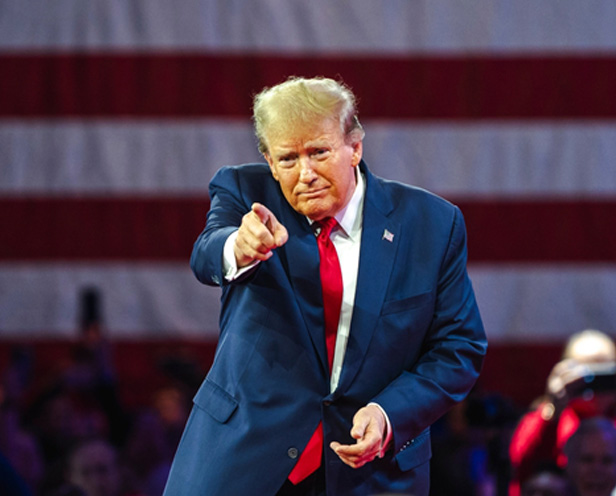CANADIAN NEWS January 20, 2025
No ‘Day One’ New Trump Tariffs, But President Says the Levies Are Coming
Intensified import duties are a strong possibility under the United States’ just-sworn-in 47th president. Some could be coming as soon as Feb. 1.
Key Takeaways
• Not Just Yet: President Trump is not immediately imposing new tariffs but is signing executive orders to analyze trade issues.
• Tariff Focus: Trump has ordered a study of tariffs for national security, as well as an analysis of the de minimis trade exemption.
• Levies Likely? Trump reiterated that he’s a huge proponent of tariffs and indicated that more import duties are in the cards during his second term.
UPDATE Jan. 22 8 a.m.
This article was updated to reflect the president's comments regarding the potential for new tariffs on China by Feb. 1, as well as reiterated threats regarding 25% levies on imports from Mexico and Canada.
President Donald Trump didn't immediately pull the trigger on new import tariffs, but it's possible he'll do so soon.
Trump had threatened to implement new and increased duties on imports on his first day in office but did not so, though he indicated the levies remain part of his second-term plans and on Jan. 21 threatened to impose additional tariffs of 10% on China-made products by Feb 1.
Sworn into office on Monday, Jan. 20, the United States' 47th president signed executive orders that included directives that federal agencies start analyzing an array of trade issues.

Trump is ordering federal authorities to study things like the trade deficit; trade deals with China, Canada and Mexico; other nations’ practices with regard to trade and currency; and the degree to which countries have complied with two trade deals the president enacted during his first term.
Tariffs also are, of course, a primary focus for Trump. His order calls for a study of tariffs the United States has implemented for national security purposes. He’s also commanding an analysis of the de minimis trade exemption, which enables lower-value products and materials to come into the United States duty-free.
Levies Likely
While Trump did not ink tariffs into law on his first day in office, he remains a big fan of import levies and asserted that he does intend to mandate more. On Jan. 21, he threatened to impose more tariffs on China by Feb. 1.
"We’re talking about a tariff of 10% on China based on the fact that they’re sending fentanyl to Mexico and Canada,” said Trump, referring to the illicit drug that's contributing to an addiction crisis in America.
“If the US imposed an additional 10% tariff on China and China responded in kind, U.S. GDP would be $55 billion less over the four years of the second Trump administration, and $128 billion less in China,” the U.S.-based Peterson Institute for International Economics said in a Jan. 17 report.
Trump also threatened potential levies of 25% on Mexico and Canada. “We’re thinking in terms of 25% (levies) on Mexico and Canada, because they’re allowing a vast number of people” to cross into the United States illegally, Trump said.
Canada is reportedly preparing counter-tariffs in response. Trump also is considering placing tariffs on the European Union.
“I will immediately begin the overhaul of our trade system to protect American workers and families,” Trump said in his Jan. 20 inauguration speech. “Instead of taxing our citizens to enrich other countries, we will tariff and tax foreign countries to enrich our citizens.”
On Inauguration Day, Trump reiterated plans to establish a new federal agency dedicated to collecting tariff revenue.
The “T” word – #tariffs – is abuzz again in the #promoproducts industry. https://t.co/RZy6tCLK5P
— Chris Ruvo (@ChrisR_ASI) November 20, 2024
“We are establishing the External Revenue Service to collect all tariffs, duties and revenues,” the president said. “It will be massive amounts of money pouring into our Treasury coming from foreign sources.”
Currently, U.S. Customs and Border Protection collects tariffs. While the president states that foreign companies pay the levies, they’re actually paid by U.S.-based companies bringing in products from abroad. This heightened cost can lead companies to pass at least some of the increased expense along to their customers, be they consumers or other businesses.
Such a phenomenon played out in the promotional products industry when Trump instituted tariffs on billions of dollars’ worth of China-made imports during his first term. Promo suppliers said they absorbed what they could, but many passed some of the cost along to distributors, who in turn passed the cost on to end-buyers.
The vast majority of promotional products sold in the United States are produced in overseas factories, particularly in Asia, with China being the most common manufacturing source. Suppliers have told ASI Media that if Trump were to ratchet up tariffs on China imports and implement new levy mandates on additional countries, then they’d probably have to increase prices on the products they sell.
“We have largely absorbed other inflationary and noninflationary increases over the past 24 months, so upward tariff adjustments would likely force us to pass them through in our pricing,” an executive at a leading supplier who wished to remain anonymous told ASI Media in late 2024. “Obviously, we work as hard as possible to minimize price increases, but at the levels they are talking, it will be difficult for most suppliers to completely hold back.”
